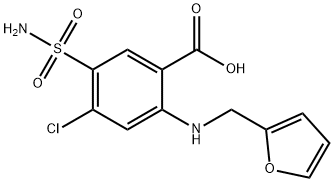
Frusemide
- Product NameFrusemide
- CAS54-31-9
- CBNumberCB00127197
- MFC12H11ClN2O5S
- MW330.74
- EINECS200-203-6
- MDL NumberMFCD00010549
- MOL File54-31-9.mol
- MSDS FileSDS
Chemical Properties
| Melting point | 220 °C (dec.) (lit.) |
| Boiling point | 582.1±60.0 °C(Predicted) |
| Density | 1.606 |
| refractive index | 1.6580 (estimate) |
| Flash point | 11 °C |
| storage temp. | 2-8°C |
| solubility | Practically insoluble in water, soluble in acetone, sparingly soluble in ethanol (96 per cent), practically insoluble in methylene chloride. It dissolves in dilute solutions of alkali hydroxides. |
| pka | pKa 3.8 (Uncertain) |
| form | powder |
| color | White to Off-White |
| biological source | rabbit |
| Water Solubility | Soluble in acetone, DMF or methanol. Slightly soluble in water |
| Merck | 14,4309 |
| BCS Class | 2 (CLogP), 4 (LogP) |
| Stability | Stable, but light sensitive, air sensitive and hygroscopic. Incompatible with strong oxidizing agents. |
| InChIKey | ZZUFCTLCJUWOSV-UHFFFAOYSA-N |
| CAS DataBase Reference | 54-31-9(CAS DataBase Reference) |
| FDA UNII | 7LXU5N7ZO5 |
Safety
| Symbol(GHS) |
 
|
| Signal word | Danger |
| Hazard statements | H302-H360FD |
| Precautionary statements | P202-P264-P270-P280-P301+P312-P308+P313 |
| Hazard Codes | T,F,Xi |
| Risk Statements | 61-39/23/24/25-23/24/25-11-36/37/38 |
| Safety Statements | 7-16-36/37-45-53-36/37/39-22-36-26 |
| RIDADR | UN 1230 3/PG 2 |
| WGK Germany | 3 |
| RTECS | CB2625000 |
| HS Code | 2935904000 |
| Hazardous Substances Data | 54-31-9(Hazardous Substances Data) |
| Toxicity | LD50 orally in female, male rats: 2600, 2820 mg/kg (Goldenthal) |



